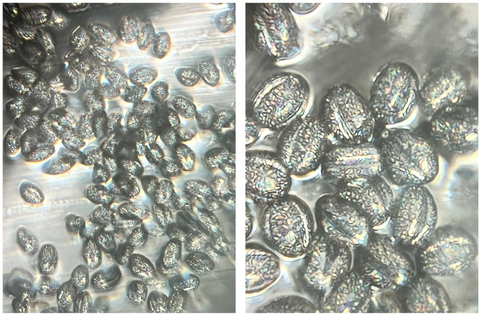It is March and spring flowers are starting to bloom. The flowers growing next to my house have prominent stamens topped with anthers covered in pollen. Of course, I wondered what the pollen would look like under my Foldscope!

How to Make the Slide
Pollen is best viewed as a dry mount slide. This means that the sample is placed directly on the slide without adding any liquid. Pollen is easy to put on a slide. Take a clear sticker and gently touch the sticky side to the anther of the flower to pick up some pollen grains. Place the sticker on a slide and put the slide into your Foldscope to see what pollen looks like at 140X magnification!

Magnification Changes
It is amazing how a Foldscope allows you to see powdery pollen as distinct pieces at 140X magnification. But the Foldscope 2.0 can take you even further into the microscopic world! Replacing the 140X lens with the 340X lens lets you see even more details on the individual pollen grains!

Lighting Techniques
Another fun thing to do with pollen is to change the lighting. The Foldscope 2.0 LED light module has a reflective lighting setting. This lets light illuminate the pollen grains from the top rather than the bottom. This has the effect of making the pollen look like it is glowing against a black background.

I love that a Foldscope lets you take a powder with no definition and see the beauty within. This is part of the fun of microscopy - it gives you the ability to see the world in a whole new way.

Have you looked at pollen under a Foldscope 2.0? Use your Foldscope to dive into the microscopic world and find the beauty that is there waiting for you. Share your microscopic images and thoughts on the Microcosmos. Be sure to tag us on social media when you post the results of your explorations, creations, and discoveries! We love to see how Foldscopers around the world are using their Foldscopes in new and innovative ways!
Facebook: @Foldscope
Twitter: @TeamFoldscope
Instagram: @teamfoldscope
Threads: @teamfoldscope



